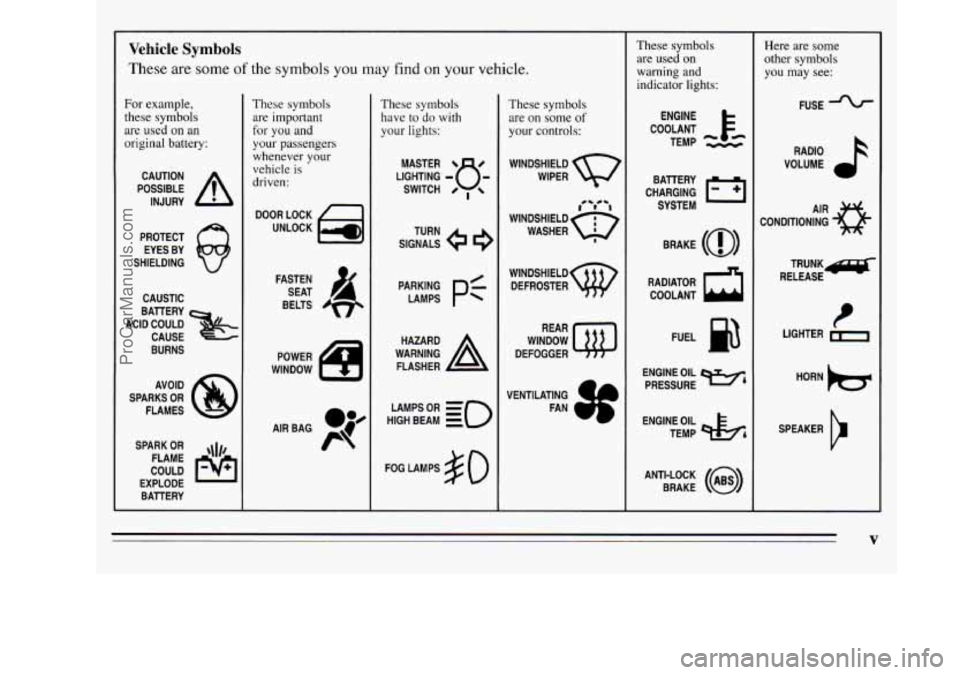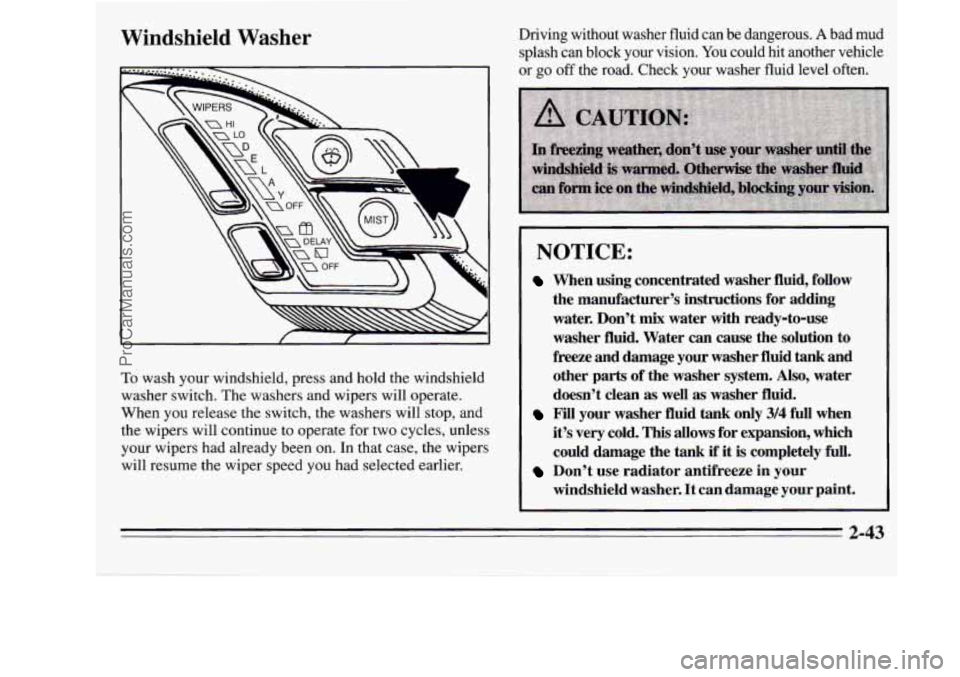Page 9 of 390

L
Vehicle Symbols
These are some of the symbols you may find on your vehicle.
For example,
these symbols are used on an
original battery:
POSSIBLE A
CAUTION
INJURY
PROTECT EYES BY
SHIELDING
CAUSTIC
ACID COULD BAlTERY
CAUSE
BURNS
AVOID
SPARKS
OR
FLAMES
SPARK
OR ,111,
COULD FLAME
EXPLODE BAllERY
These symbols are important
for you and
your passengers whenever your
vehicle is
driven:
DOOR LOCK
UNLOCK
FASTEN SEAT
BELTS
POWER
WINDOW
These symbols have to do with
your lights:
SIGNALS e e3
TURN
WARNING
A
HAZARD
FLASHER
HIGH
LAMPSoR BEAM = zo
FOG LAMPS $0
These symbols
are on some
of
your controls:
WINDSHIELD
WIPER
WINDSHIELD DEFROSTER
WINDOW
DEFOGGER
VENTILATING FAN
These symbols are used on
warning and
indicator lights:
COOLANT F-
TEMP --
ENGINE
CHARGING BAllERY
SYSTEM
BRAKE
(a)
RADIATOR COOLANT
a
FUEL
ENGINE OIL
PRESSURE
w4
TEMP OIL pk;
ANTI-LOCK (a)
BRAKE
Here are some
other symbols
you may see:
FUSE
RADIO
VOLUME
CONDITIONING
43
TRUNX~
RELEASE
HORN
)tr
SPEAKER
b
V
ProCarManuals.com
Page 113 of 390

Windshield Washer
To wash your windshield, press and hold the windshield
washer switch. The washers and wipers will operate.
When you release the switch, the washers will ‘stop, and
the wipers will continue to operate for two cycles, unless
your wipers had already been
on. In that case, the wipers
will resume the wiper speed you had selected earlier. Driving without
washer fluid can be dangerous.
A bad mud
splash can block your vision. You could
hit another vehicle
or go off the road. Check your washer fluid level often.
NOTICE:
When using concentrated washer fluid, follow
the manufacturer’s instructions for adding
water. Don’t
mix water with ready-to-use
washer fluid. Water can cause the solution to
freeze and damage your washer fluid
tank and
other parts of the washer system.
Also, water
doesn’t clean
as well as washer fluid.
Fill your washer fluid tank only 3/4 full when
it’s very cold.
This allows for expansion, which
could damage the tank
if it is completely full.
windshield washer.
It can damage your paint.
Don’t use radiator antifreeze in your
2-43
ProCarManuals.com
Page 239 of 390
3800 V6: Cooling System
When you decide it’s safe to lift the hood, here’s what
you’ll see: If
the coolant inside the coolant recovery tank is boiling,
don’t do anything else until it cools down.
(A) Coolant recovery tank
(B) Radiator pressure cap
(C) Electric engine fan (or fans if you have the 3800 V6
engine).
3.1L V6: Recovery Tank Level
5-17
ProCarManuals.com
Page 240 of 390
3800 V6: Recovery Tank Level
l I I
The coolant level should be at or above the FULL HOT
mark. If it isn’t, you may have a leak in the radiator
hoses, heater hoses, radiator, water pump or somewhere
else in the cooling system.
I NOTICE:
Engine damage from running your engine
without coolant isn’t covered by your warranty.
If there seems to be no leak, with the engine on, check to
see if the electric engine fan is running.
If the engine is
overheating, the fan should be running.
If it isn’t, your
vehicle needs service.
5-18
ProCarManuals.com
Page 241 of 390
How to Add Coolant to the Coolant
Recovery Tank
If you haven’t found a problem yet, but the coolant
level isn’t at or above the
FULL HOT mark, add a
50/50 mixture of clean water (preferably distilled) and
a proper antifreeze at the coolant recovery tank. (See
“Engine Coolant” in the Index for more information
about the proper coolant
mix.)
NOTICE:
In cold weather, water can freeze and crack the
engine, radiator, heater core and other parts. Use
the recommended coolant.
When the coolant in the coolant recovery tank is at or
above the
FULL HOT mark, start your vehicle.
If the overheat warning continues, there’s one more
thing you can try. You can add the proper coolant mix
directly to the radiator, but be sure the cooling system
is
cool before you do it.
5-19
ProCarManuals.com
Page 243 of 390
How to Add Coolant to the Radiator
1. You can remove the radiator pressure cap when the
cooling system, including the radiator pressure cap
and upper radiator hose,
is no longer hot. Turn the
pressure cap slowly to the left until it first stops.
(Don't press down while turning the pressure cap.)
If you hear a hiss, wait for that
to stop. A hiss means
there is still some pressure left.
2. Then keep turning the pressure cap, but now push
down as you turn it. Remove the pressure cap.
3800 V6: Removing the Pressure Cap
3. Fill the radiator with the proper mix, up to the base
of the filler neck.
4. Then fill the coolant recovery tank to the FULL
HOT mark.
3.1L V6: Removing the Pressure Cap
5-21
ProCarManuals.com
Page 244 of 390
3.lL V6: Upper Radiator Hose
5. plTt the cap back on the coolant recovery tank, but
leave .the radi@or pres- cap off.
3800 V6: Upper: *' Radiator Hose
6. Start the engine and let it run until you can $eel the
upper radiator hose getting hot. Watch out
for the
engine fan(
s) .
5-22
ProCarManuals.com
Page 245 of 390
1. BY tnls time tne coolant level inside the radiator
filler neck may be lower.
If the level is lower, add
more
of the proper mix through the filler neck until
the level reaches
the base of the filler neck.
3800 V6: Replacing the Pressure Cap
3.1L V6: Replacing the Pressure Cap 8. Then replace the pressure cap. At any time during
this procedure
if coolant begins to flow out of the
filler neck, reinstall
the pressure cap. Be sure the
arrows on the pressure cap line up
as shown.
5-23
ProCarManuals.com